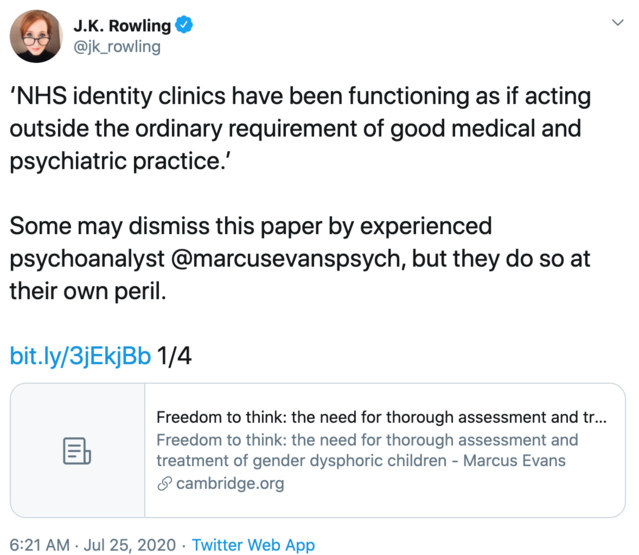Transgender
JK Rowling and the Chamber of Trans Youth Misinformation
JK Rowling tweeted a paper about trans youth that's full of misinformation.
Posted July 28, 2020 Reviewed by Abigail Fagan
JK Rowling has continued to tweet about her newfound interest in the mental health of transgender youth. A few days ago, she shared a paper by psychoanalyst Marcus Evans, noting that those who dismiss the paper "do so at their own peril." I'm willing to take that risk. The paper has a range of inaccuracies and omissions that I'll outline here. Transgender youth deserve to live in an environment where the media accurately discusses the research on how to best support them. Spreading misinformation is dangerous.

Common Ground
Before jumping into the paper's inaccuracies, I want to point out that the author and I share common ground on two points.
First, the author challenges the idea that "if you have gender dysphoria, you must transition." I agree that this is not true. Medical and surgical transition are highly personal decisions, and not all transgender people or people with gender dysphoria will desire these interventions. That being said, a large number of people do desire these interventions and benefit from them.
Second, I agree that if doctors are providing medical interventions without explaining the risks and benefits, this would be unethical. Endocrine Society guidelines clearly state that providers must explain the risks and benefits of any intervention. Doctors should also counsel patients on the risks and benefits of no treatment. This is true in all of medicine. Every gender clinic I've seen does so. Again, if one does not, that would be unethical.
"Rapid Onset Gender Dysphoria"
The paper claims that there is a new diagnostic entity called "rapid-onset gender dysphoria." This term comes from a paper published in the journal PLoS One, in which the author anonymously surveyed parents recruited from websites that focus on the theory that trans youth identify as transgender due to "social contagion" and online influences. Unfortunately, the paper did not survey any of the youth themselves or their clinicians. The only thing the paper established is that some people online believe that youth rapidly become transgender as a result of watching trans-related content on Youtube and Reddit.
People should be aware that parents often think that transgender youth became transgender "all of a sudden," because youth were closeted prior to coming out, due to fear of family rejection. Presumably, youth with parents who believe being transgender is a disease would be likely to conceal their identity for prolonged periods of time. It would be important to interview the youth themselves to know if this were the case.
Despite the study's methodological limitations, the paper immediately garnered substantial media attention. Soon after, it came under critique by experts in the field. This led the journal to publish a correction on the paper in which the author explains that the study did not establish a new diagnostic entity. Below is the quote from the correction.
Rapid-onset gender dysphoria (ROGD) is not a formal mental health diagnosis at this time. This report did not collect data from the adolescents and young adults (AYAs) or clinicians and therefore does not validate the phenomenon.
The paper that Rowling shared on Twitter goes on to claim that "a substantial proportion" of referrals to gender clinics are for youth with this "rapid onset gender dysphoria." It provides no citation for this claim. There are no data showing that this is true.
Research Omissions
The paper contains a section entitled "research" in which the author quotes a number of people regarding their thoughts on medical interventions for transgender youth. However, it fails to cite any of the many papers that show medical interventions for transgender youth result in favorable mental health outcomes. These include:
De Vries, A. L., McGuire, J. K., Steensma, T. D., Wagenaar, E. C., Doreleijers, T. A., & Cohen-Kettenis, P. T. (2014). Young adult psychological outcome after puberty suppression and gender reassignment. Pediatrics, 134(4), 696-704.
Costa, R., Dunsford, M., Skagerberg, E., Holt, V., Carmichael, P., & Colizzi, M. (2015). Psychological support, puberty suppression, and psychosocial functioning in adolescents with gender dysphoria. The Journal of Sexual Medicine, 12(11), 2206-2214.
Turban, J. L., King, D., Carswell, J. M., & Keuroghlian, A. S. (2020). Pubertal suppression for transgender youth and risk of suicidal ideation. Pediatrics, 145(2).
Achille, C., Taggart, T., Eaton, N. R., Osipoff, J., Tafuri, K., Lane, A., & Wilson, T. A. (2020). Longitudinal impact of gender-affirming endocrine intervention on the mental health and well-being of transgender youths: preliminary results. International Journal of Pediatric Endocrinology, 2020(1), 1-5.
Allen LR, Watson LB, Egan AM, Moser CN. Well-being and suicidality among transgender youth after gender-affirming hormones. Clinical Practice in Pediatric Psychology. 2019;7(3):302.
Kuper LE, Stewart S, Preston S, Lau M, Lopez X. Body Dissatisfaction and Mental Health Outcomes of Youth on Gender-Affirming Hormone Therapy. Pediatrics. 2020;145(4).
Conflating Stages of Development
The paper states that most clinicians caring for transgender youth use something called the "watchful waiting" approach. This approach has been described by the Center for Expertise on Gender Dysphoria in Amsterdam, the first clinic to offer gender-affirming medical interventions for transgender adolescents. The approach involves waiting until transgender youth reach puberty before recommending that they socially transition (i.e. start living with a name, pronouns, clothing, etc. that match their gender identity). This approach is only about prepubertal children, who do not receive medical interventions under any clinical guidelines. The watchful waiting approach is irrelevant to the discussion of medical interventions for transgender youth. Under existing guidelines, these interventions are never offered before the onset of puberty.
The paper also states that most kids with gender dysphoria "desist" in their transgender identity if not treated with gender-affirming medical interventions. The author again cites papers that examined prepubertal children. Since medical interventions are not offered until puberty, the relevant question is how common "desistence" is after pubertal onset. This such "desistence" is rare after the onset of puberty. I've written more on that topic here and here for those interested in reading more.
False Implication That Gender Affirmation Makes Kids Identify More Strongly As Transgender
The paper states (without citing any evidence) that prepubertal social transition sends children "down a path" of continuing to identify as transgender, which subsequently results in medical interventions. First of all, existing research suggests that early social transition does not make youth identify more strongly as transgender. Second of all, not all transgender folks ultimately desire medical interventions.
In our recent study of over 20,000 transgender young adults, only 17% of transgender participants reported ever wanting pubertal suppression. Starting medical interventions is a highly personal decision that varies from person to person.
False Assertion That Research Has Established Psychosocial Determinants of Gender Identity
The paper states that there is "a growing body of knowledge that connects the development of gender dysphoria with psychological factors" and provides six citations. None of the citations show that there are psychological or environmental causes of gender dysphoria, and some are completely unrelated. One is a post on Medium and another is a fully unrelated paper about surgical outcomes among transgender adults.
None contain data showing that there are psychological causes of identifying as transgender or that transgender identity can be "reversed." No study to date has established an environmental or psychological determinant of gender identity. In contrast, twin studies suggest that gender diversity is as much as 70% heritable (see the section on "biological factors" here).
False Assertion That The Gender Affirmative Model Does Not Allow For Gender Identity Exploration
The paper claims that gender affirmative models do not allow providers to explore with patients their "underlying belief systems and motivations," or else they will be accused of conversion therapy. This is not true. The American Academy of Child & Adolescent Psychiatry's policy statement on conversion therapy clearly states providers should engage in open exploration of identity with youth. An approach is only conversion therapy if it has the pre-defined goal of a specific gender identity.
Health promotion for all youth encourages open exploration of all identity issues, including sexual orientation, gender identity, and/or gender expression according to recognized practice guidelines. This fosters healthy development, especially for sexual and gender diverse youth, as they integrate their sexual orientation, gender identity, and/or gender expression, into their overall identity without any pre-determined outcome.
Conclusion
Transgender youth suffer from dramatic mental health disparities, including elevates rates of anxiety, depression, and suicidality compared to their peers. They deserve ongoing research on how to best support their mental health. They also deserve accurate discussions of the existing literature on how to best support them.
All existing literature suggests that affirming transgender youth in their gender identities and exploring their identities with them without having a pre-defined goal results in superior mental health. In contrast, all data suggests that trying to force them to be cisgender results in bad mental health outcomes.




